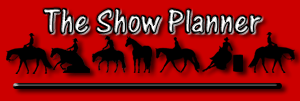 |
|
Show Horse Promotions Mary Murray
|
Selecting Hays For HorsesHigh quality forage normally makes up 40-100% of the horses diet, depending upon work load and physiological stage of development. Horses readily eat several kinds of grass and legume hay, especially when it is leafy and of high quality. There are two primary ways to evaluate hays (a) chemical testing, (b) visual appraisal. While visual appraisal can give a general indication of the quality, only; chemical testing can estimate the nutritive value. In addition to the nutritive value of hay, one needs to know:
|
| Large, long stems which are hard and rigid are undesirable. | |
| Small, flexible stems are desirable. |
Color is an unreliable measure of hay quality. It is influenced by fertilization, sun bleaching, curing, moisture content and species. All hays will gradually "lose color" with storage.
| A bright, dark green color in hay usually indicates high vitamin and protein content. | |
| Browning of hay usually indicates a loss of nutrients. A dark brown color occurs in heat-damaged hay while a lighter shade brown is evident in un-bleached hay. Aroma. Smell the hay for any unusual odors. |
A musty or moldy odor indicates that the hay was baled too wet. If this odor is detected, check for evidence of mold.
| Mold will appear as a grayish white, flaky substance or "dust", usually located in tightly packed sections of the bale. | |
| PRESENCE OF MOLD USUALLY ELIMINATES THE HAY AS A HORSE FEED. |
Foreign Material - All materials considered foreign to pure or mixed hays will alter the nutritive value, and some may be dangerous such as: rushes, stubble, bottles, glass, wire, burs, thorns, barbs, poisonous plants and others.
If you wish to have get a forage analysis done on hay, contact Ben Chase, Rockingham County Livestock Agent with the North Carolina Cooperative Extension Service at 336-342-8230 (or your county Extension Office) and request the forage analysis kit. In North Carolina the Department of Agriculture conducts the analysis for
~$10 a sample for In-State Residence.
--
Ben E Chase
Email : benchase@rockingh.ces.ncsu.edu
Phone : (336) 342-8230
![]()
© 2000 - 2010 Show Horse Promotions
All Rights Reserved
Privacy Statement
The Show Horse Promotions web site is an informational web site, this information is subject to change without notice. Any use of, or actions taken based upon any of the information contained on this web site is done entirely at your own risk.
Show Horse Promotions expressly prohibit you from republishing or redistributing this content without first receiving our written consent. By using this site, you agree not to hold us liable for any errors or delays in this content, or for any actions that you take in reliance thereon. This site contains links to other Internet sites. These links are not endorsements by us of any products or services in those sites, and we have not endorsed or approved any information in those sites.
|
||||||||
